How to Record an Acoustic Guitar with a Dynamic Microphone
by Dave Fox
Today I’m going to discuss recording your acoustic guitar with a dynamic microphone. There’s a lot of things to consider, so let’s jump right in!
What is a Dynamic Microphone?
Good question to kick things off here. Dynamic microphones are durable, all purpose mics that require no power source to operate. Most working musicians have at least one or two of them lying around any given studio, or jam hall.

While typical dynamics mic don’t capture the range of frequencies and sonic nuances of a high quality condenser mic they can be great for a performance that has a lot of energy where you don’t want to hold back. This is why dynamic mics appeal to certain types of artists – especially rockers. They are simply designed to take more abuse, in general, than condenser mics.
Difference between Dynamic and Condenser Mics
Recording engineers will sometimes opt for using both a condenser mic and a dynamic mic at the same time for recording an instrument, since both mics have different properties and capture sound differently. It’s worth knowing these differences, before you go out and buy any mics for the express purpose of recording.
Here’s a graphic that shows some of the essential differences between dynamic mics and condenser mics, in case you’re wondering.
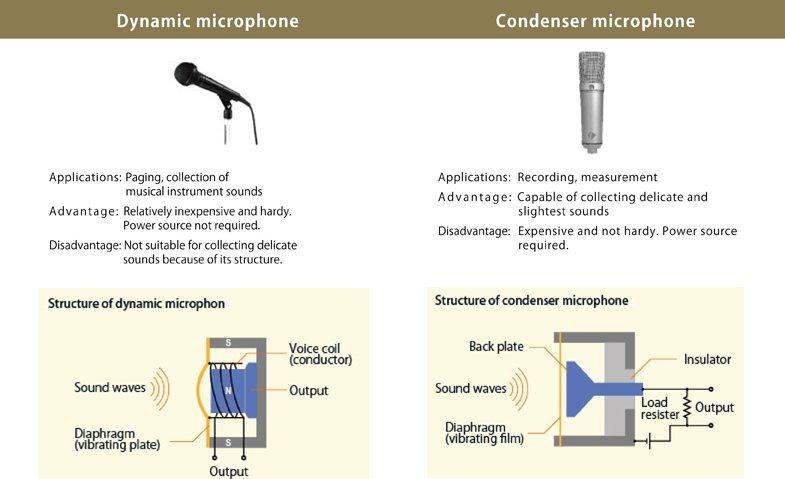
Here is a video demonstrating the difference in sound between recording an acoustic guitar using three methods – condenser mic, dynamic mic, and direct in. You can be the judge of what sounds best to you.
Don’t Record With A Damaged or Out of Tune Guitar
Before we get back to the actual miking situation, we must add quickly that you need to make sure your acoustic guitar is in good condition and properly tuned before you attempt to mic it for recording.
That guitar you found in your basement with the slightly warped neck and strings that are like 1 inch off of the fretboard? Don’t use that! That guitar your friend smashed over your head at that party last week? Don’t use that one either!
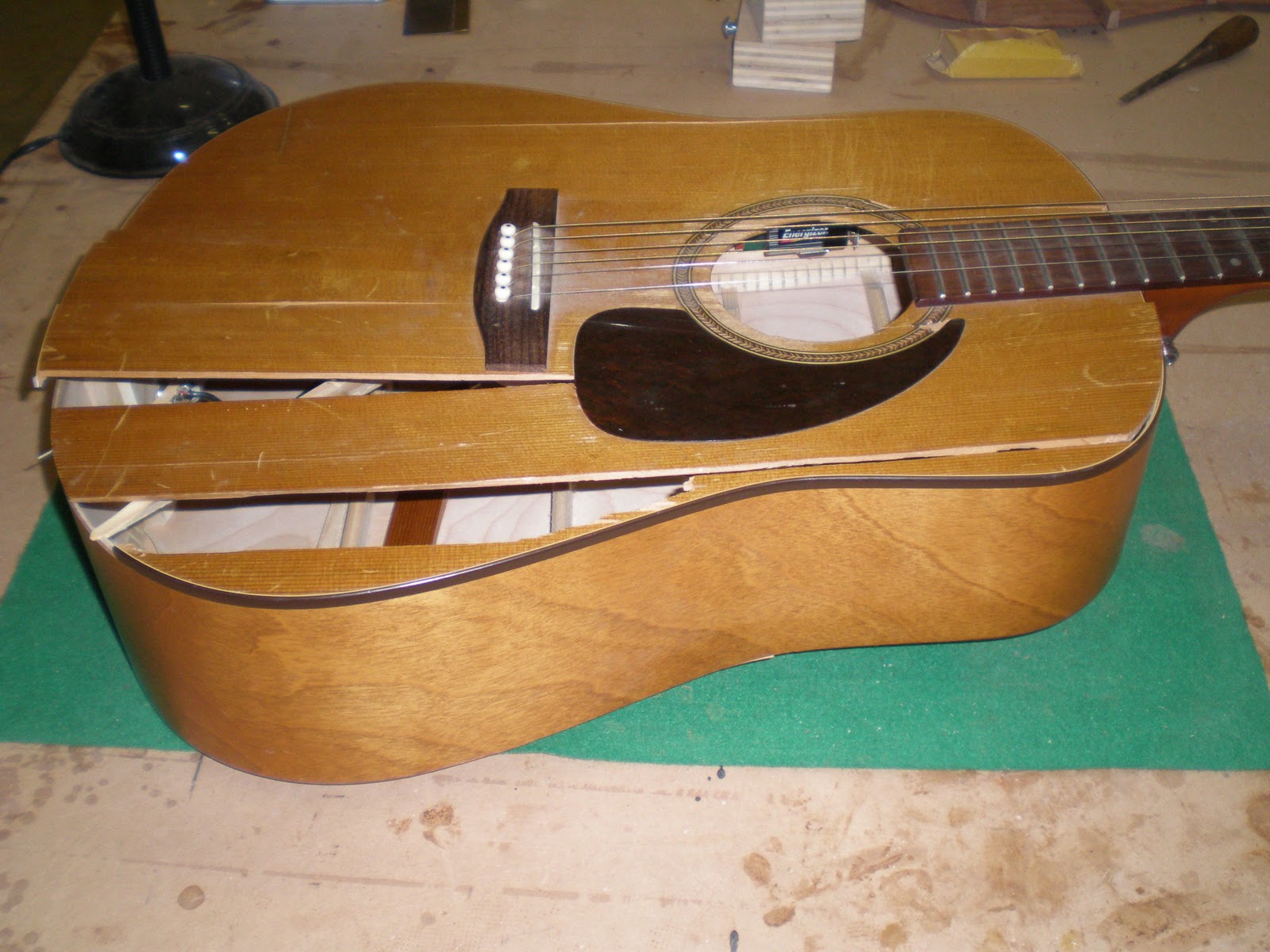
The guitar you plan to use probably won’t be as banged up as the one pictured above, but even if it is only slightly damaged, it could affect the sound of the recording in a big way.
My suggestion is, before you record, take the time to really assess the quality of your guitar. If you don’t like the sound when you play it normally, don’t expect to like the sound of that same guitar once it has been recorded!
Omnidirectional or Cardioid Microphone?
Like many of the choices you’ll make with your dynamic microphone such as placement and amount of mics, you’ll need to decide whether you want a single pick up pattern or multiple.
With a single pattern, you’re getting sound directly into one side of the mic. It’s usually the one facing the guitar. This can be good for close mics that are retrieving sound from the guitar’s sound hole.
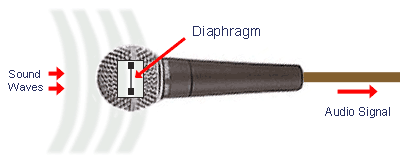
The omnidirectional microphone pattern will pick up the room’s reverb and ambience when recording. You should use this when the microphone is at a slight distance, and you want to include the reverb of a room.
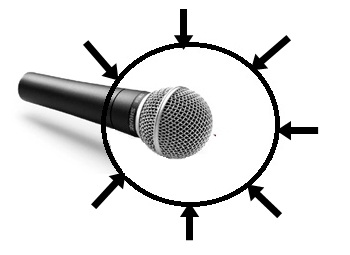
There is a misconception that dynamic mics are all unidirectional in nature. The thing is, they’re not. Well, not necessarily. Many dynamic mics happen to be unidirectional, yes, while some are omni-directional. When purchasing a dynamic mic, look at the packaging and it will tell you if it is or is not.
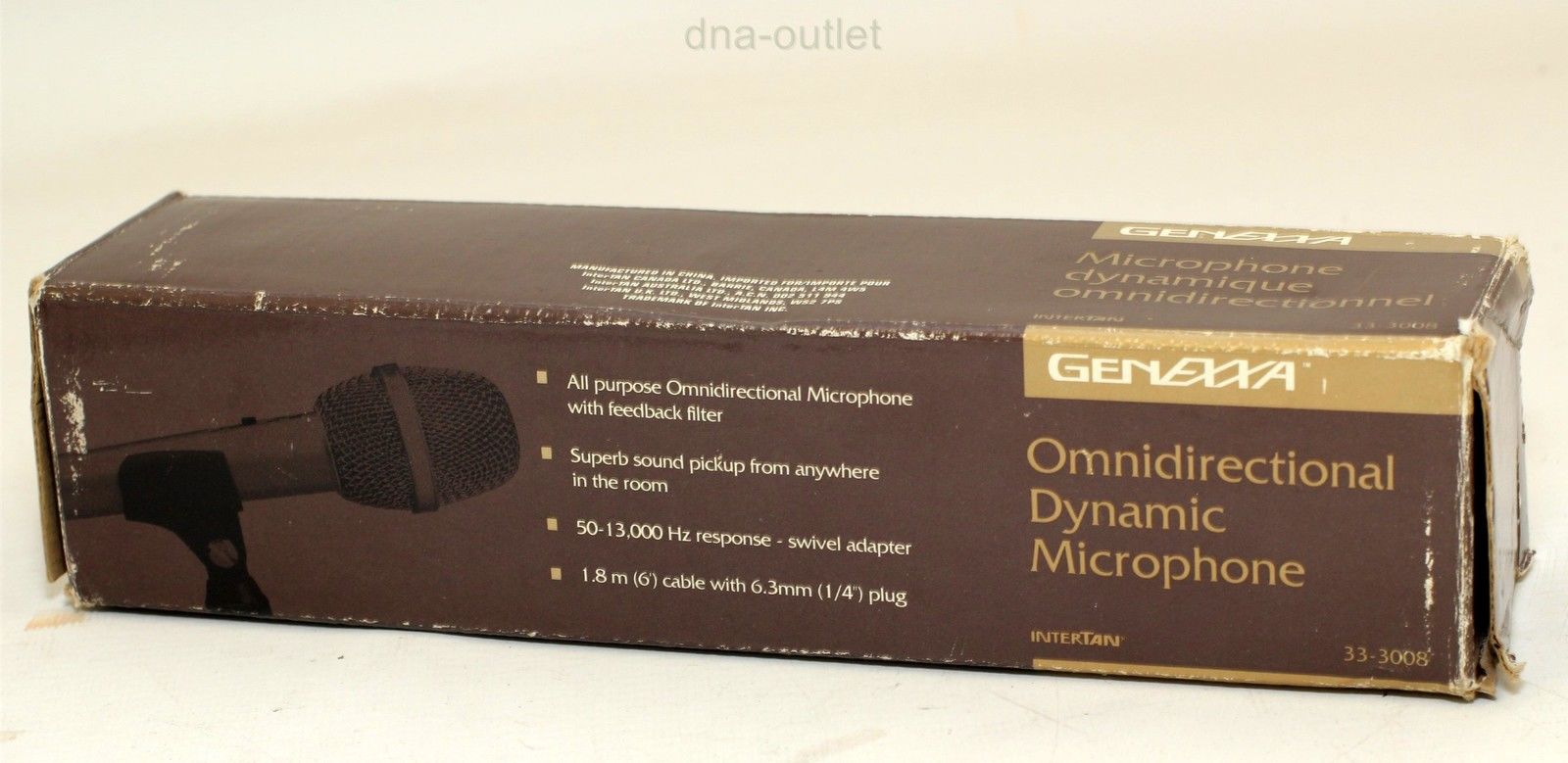
That said, in my experience, I haven’t found too many dynamic mics that let you toggle between uni or omni directional settings. With condenser mics, they often have a switch and it even has it pictured on the mic itself, like the picture of the Rode NT2A below.
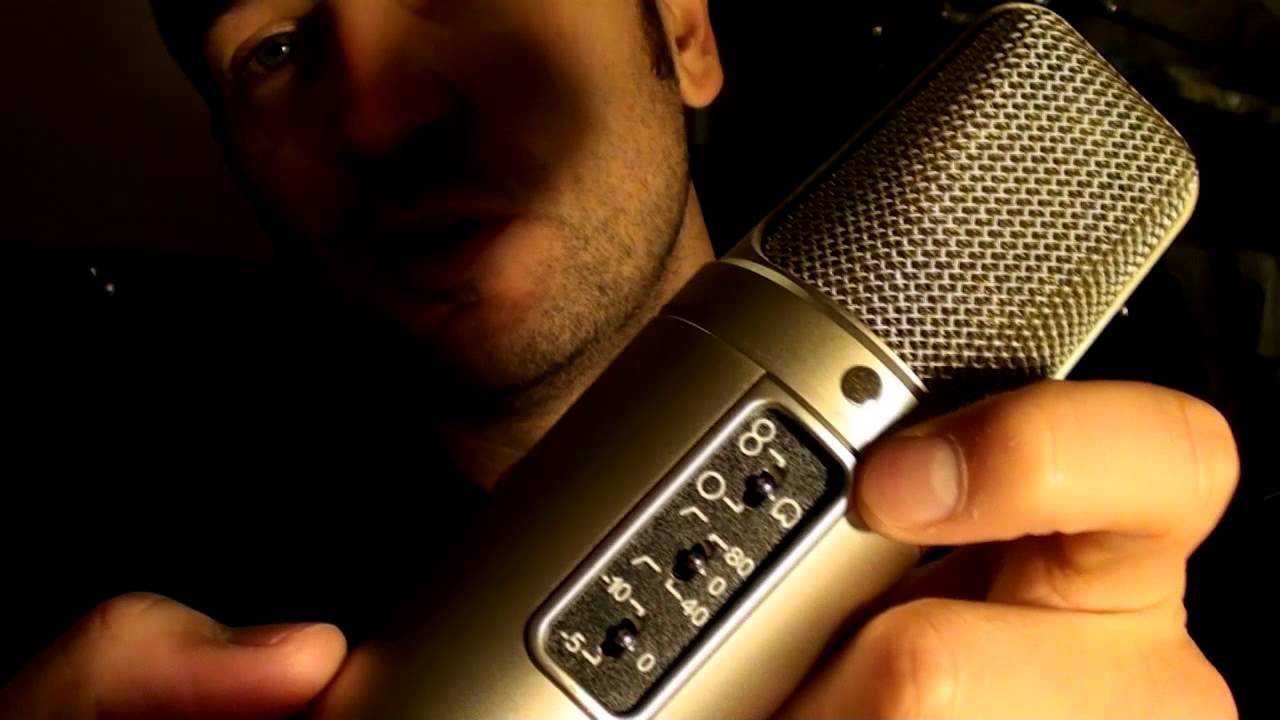
With dynamic mics, because they’re usually a bit cheaper, you don’t get any extra switches. It usually either is omnidirectional, or it isn’t (meaning it’s unidirectional). So, if you want an omnidirectional dynamic microphone to use to record your guitar, be sure that’s what you’re buying.
Mic Position and Placement
Ok, time to get down to business. You’ve got your guitar, and you’ve got your dynamic mic and you’re ready to do some recording.
Scenario #1 – Single Mic, Omnidirectional:
To start off, I’m going to assume you have only one mic do record with. As I just mentioned, if your mic is omnidirectional, this will make a difference in sound from a unidirectional dynamic mic.
If your dynamic mic is omnidirectional, you would do well to place your mic about 1 foot from your acoustic guitar’s sound hole, and slightly towards the fretboard, like this…
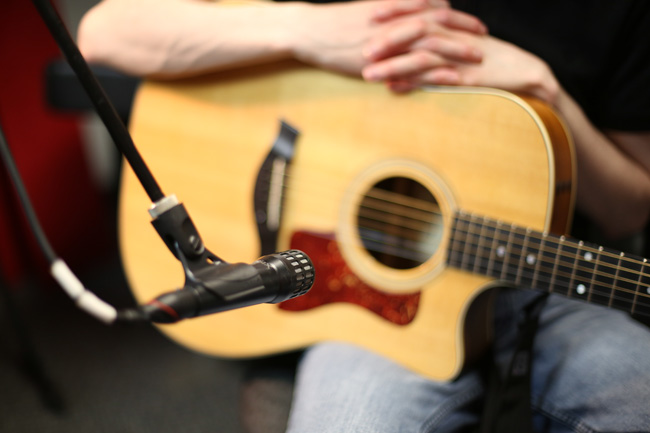
From this point, it’s just a matter of tweaking your input levels on your pre-amp, and checking to hear how things sound.
Because the mic is omni, it will pick up not just the guitar sound, but the room sound as well. Because you are back about a foot, you won’t get a super close mic’d sound, and there will be more air present in the recording than if you put the mic really close to the place you are strumming.
Hopefully, in this scenario, you get the best of both worlds, with some natural room ambience and some immediacy from the strings and the strumming.
Scenario #2 – Single Mic, Unidirectional
If your dynamic mic only captures one particular direction, then you’ll find this is a bit of a different situation from the last one. Because you’re only getting sound from one side of the mic (the front), you’ll want to mic the guitar closer, at about 6 inches, and make sure you aim it precisely at the spot between where the sound hole meets the fretboard.
This can be called “close miking”, because you’re starting to get in pretty close with the origin point of the sound, which can lead to unwanted feedback and distortion in your recording if you’re not careful.
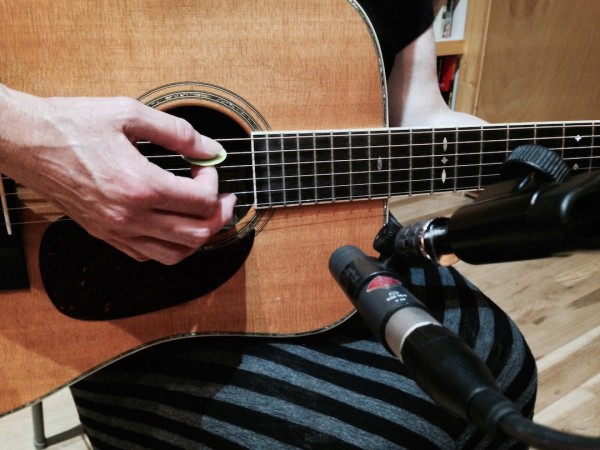
My recommendation would be to turn up your input (gain) to start on your pre-amp, and hear what kind of sound you’re getting. Be prepared to turn your input back down if it’s sounding too intense. Look at your sound waves. If they look too big, and sound distorted on playback, turn things down.
Pointing the mic where I just said is your best bet, because this is where you’re strumming, and also where the sound is projected from the guitar.
Because this is the main source of the sound the guitar is making, and your mic only captures basically one sound, this is the angle you want to aim the mic. You can point the mic slightly up at this point, or slightly down, so long as it is aimed at this particular place. You want the sound to go straight into the mic, not pass by it.
Because I don’t know what kind of guitar you have, or how hard you play, or whether your pick is thick or thin, the sound is going to vary, but this is a good place to start!
Scenario #3 – Two Mics, Unidirectional
Hey, now we’re talking! The previous scenario was a bit tougher, because you only had one mic that picks up sound only one way to work with. In this scenario, you have the benefit of two mics, but both of them are still unidirectional, so you need to be strategic as to where you aim them.
The thing is, there are literally dozens of options as to where you can point these two mics. I can’t list them all, as there are just too many to choose from. So, what I can do is tell you what I do when I have to unidirectional dynamic mics for recording acoustic guitar.
I would, first, back the mics up about 6-8 inches from the guitar. Then I could aim one at the sound hole where I was aiming before, to get the majority of the frequencies coming out of the hole. Then I’d point one mic at the strings a little higher up the neck, where you’ll get a more ambient sound. Here’s a picture of what I mean.
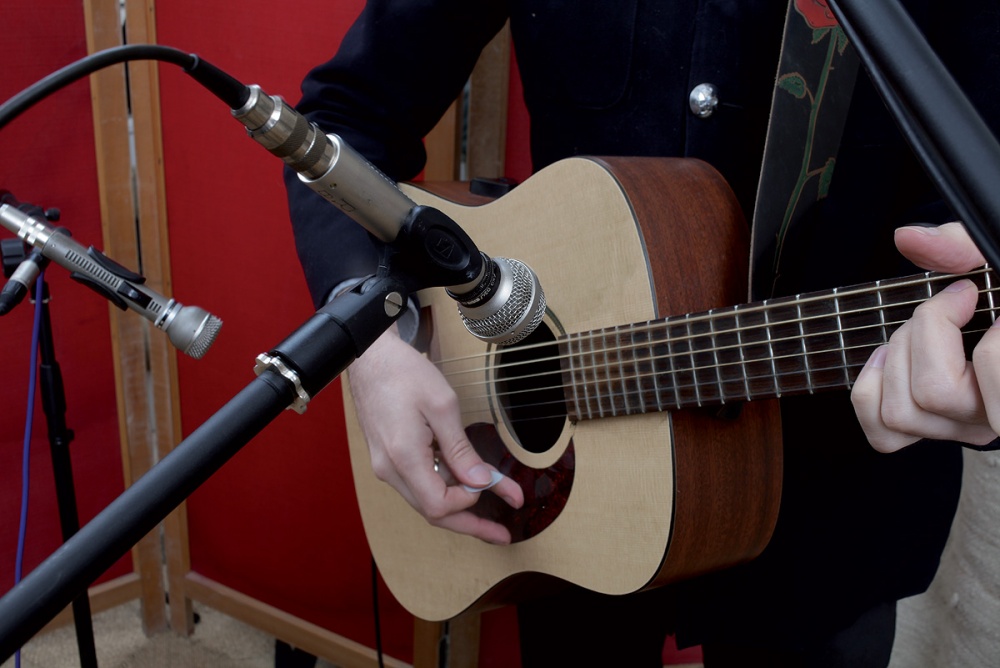
Basically, with unidirectional mics, you are sonically gathering information that you will piece together to make a complete picture of the same sound that an omnidirectional microphone can do all at once.
It might seem like an omnidirectional mic would be better, but, think of it this way – with unidirectional mics, you get to be more creative, and even more “mysterious” as you capture sounds from different and interesting angles.
Remember, dynamic mics are usually a bit less sensitive than condensers, so you can move them in a bit closer and not have to worry about them feeding back or causing distortion unless the gain on your input is up too high.
Guitar + Vocals?
If your plan is to record yourself singing and playing the guitar at once, this will require a unique miking situation.
If we assume both mics are unidirectional, we can take a cue from our 3rd scenario from above and start by miking our guitar about 6-8 inches away, pointing at that spot between the sound hole and the fretboard.
For your vocals, you’ll want to set up the stand so the dynamic mic is right up in your face, so you can practically taste it. Take a look at the picture below for a moment.
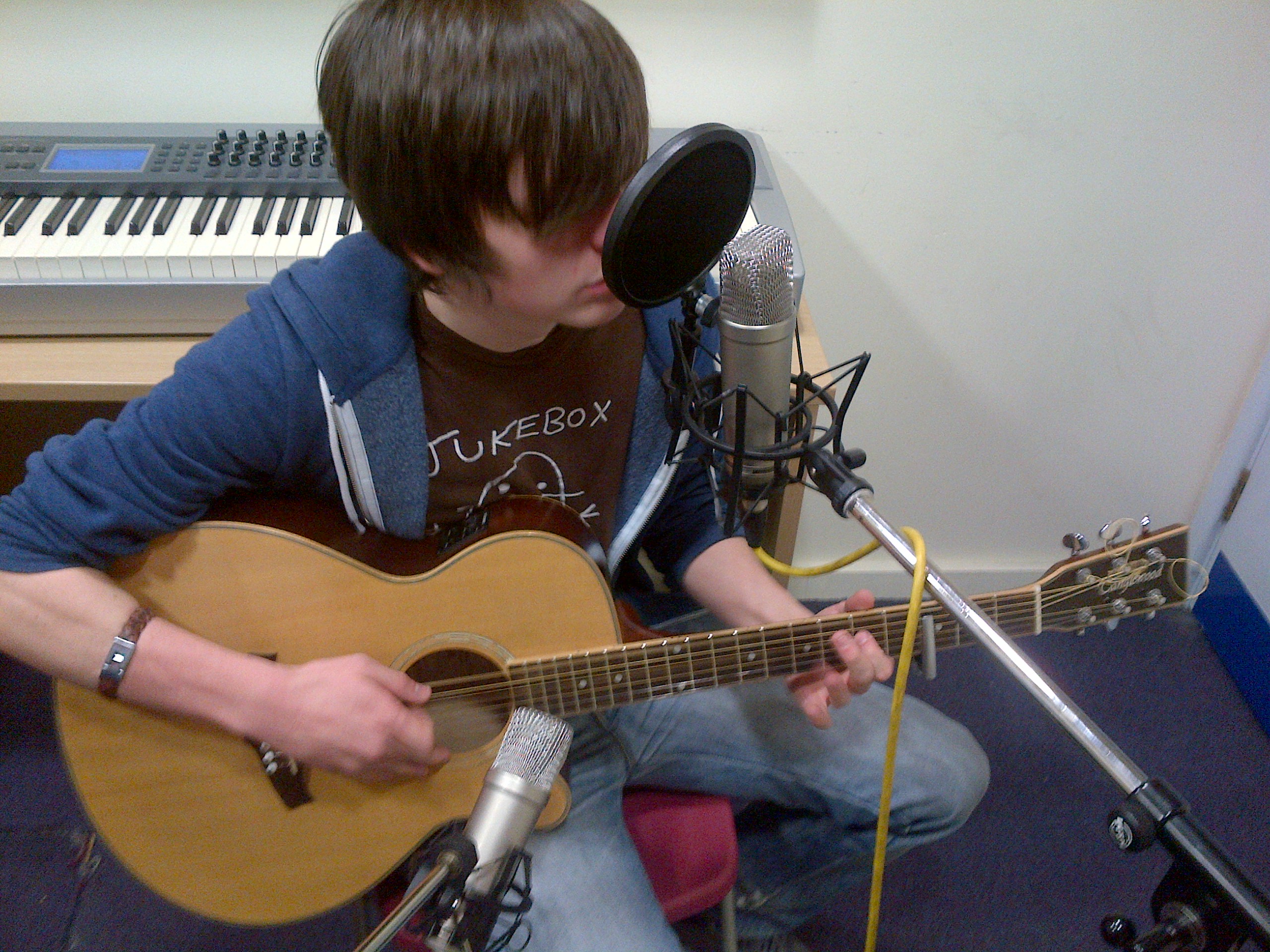
You see, this guy is using condenser mics to record himself, so it’s not quite the same as using dynamic mics, but his mic positioning is similar, so I’m showing you this picture.
The main difference here is that you don’t need a spit guard to cover your mic, because, if you’re using a dynamic mic, they are generally designed with that durable mesh, which is why you can yell into them in the first place. So, no need for that. Aside from that detail, keep the configuration about the same, but just move in closer to the mic.
Conclusion
Hopefully, this will get you asking the right questions as you shop for your microphone to make your recordings come alive. If you have questions or want to share your recording, leave a comment. It’s always great to connect with other musicians and hear how you’re contributing your own style to the music scene.
Lastly, I’ll leave you with these four basic questions that you might want to consider before you get to recording, if you haven’t run off to record already!
- How loud will the guitar be and will there be loud singing on the recording?
- What kind of room will the playing and recording take place?
- Will you be using a pick or strumming with your fingers?
- What kind of wood, soundboard, and bridge will be used for this guitar?
 |
 |
 |
 |

About Dave Fox
Recorder of many songs, haver of many albums. Dave (AKA Young Coconut) has been making music for the past twenty years or so, of varying genres and degrees of quality, to the dismay of listeners and algorithms everywhere. He’s also in the Suburban Bicycle Gang with Jerry Grey.
Dave has a keen interest in studying all aspects of music history, especially experimental / genres like jazz, krautrock, drum n’ bass, and no wave.
Here’s his Spotify: https://open.spotify.com/artist/1v3iPVEXzurahTI2Tm4Tpm
Leave a Reply
Musical Inspiration
Check for FREE Gifts. Or latest free acoustic guitars from our shop.
Remove Ad block to reveal all the rewards. Once done, hit a button below
 |
 |
 |
 |